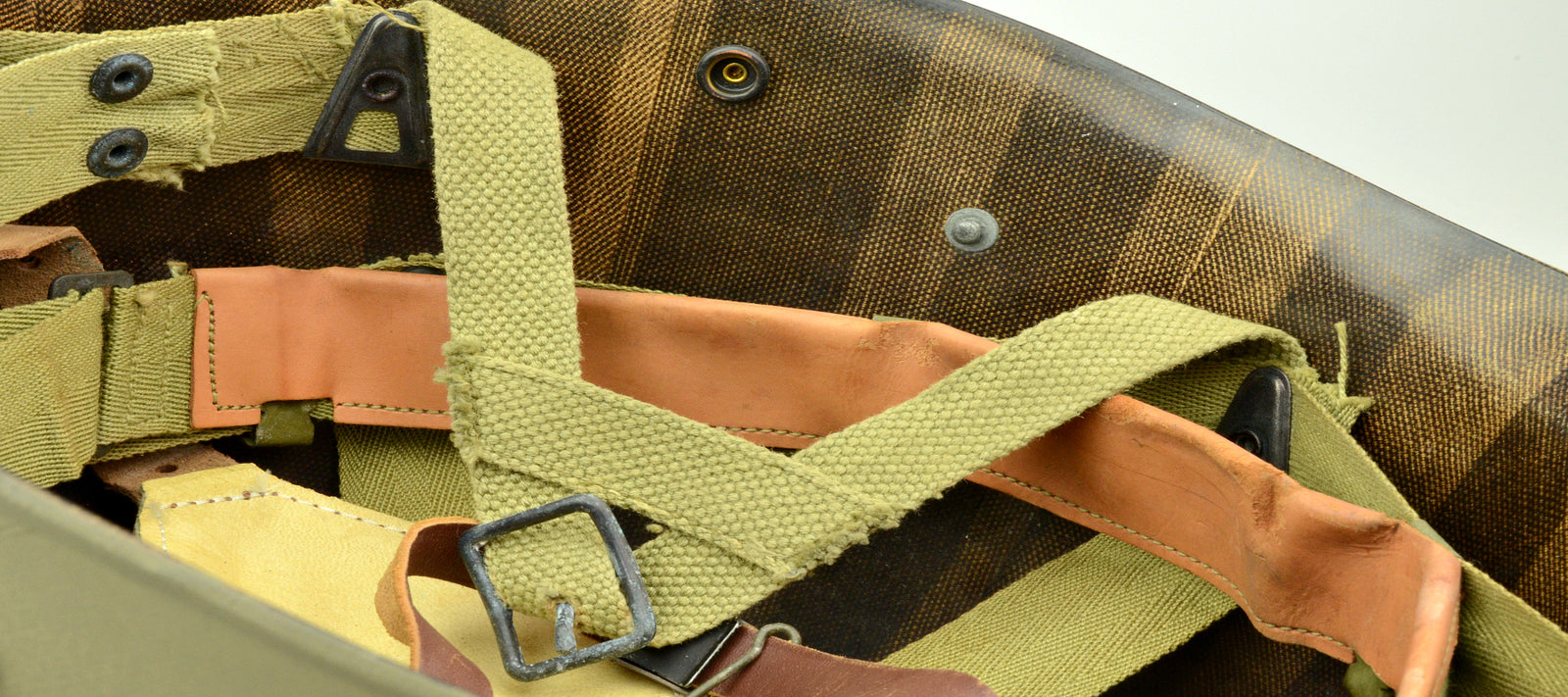Your Cart is Empty
- M1 HELMETS BASIC
- M1 Helmets Custom
- WWII US & ALLIED UNIFORMS
- WWI Uniforms
- M1 Helmet Webbing
- Vietnam Uniforms
- FEATURED UNIFORMS

INFANTRY LINERSFrontal eyelet holeA true US WWII M-1 helmet liner can be identified through the frontal eyelet hole. If an M-1 helmet liner has one, there's a good chance it was made during WWII. The piece pictured on the right is a restored "high pressure" model M-1 helmet liner. It was the most produced M-1 helmet liner made during World War II. Note: US liners produced in the 1950s and some European copies still retained that feature and some modern dealers drill them into the M1958 liners.
|
|
Cotton HBT suspension clothThe majority of US WWII M-1 helmet liners had a cotton herring bone twill (HBT) cloth suspension. The HBT cloth was either a single or multiple weave pattern. This HBT suspension was held tightly within the M-1 helmet liner by rivets and a series of triangular "A" washers. The three upper suspension bands were joined together with a shoe string. This way the wearer could adjust the fit. Note: A true US WWII M-1 helmet liner would alway have this string tie. Later M-1 helmet liners made in the 1960s did not.
|
|
Back & nape strapA distinguishing feature of the US WWII M-1 helmet liner was the back-strap. The back-strap was a single piece of cloth that had four female-ended snaps within it. It was riveted to the back of the liner near the base of the wearer's neck (also called the "nape"). The back-strap was used in conjunction with the "nape" strap. The nape strap was another method used to guarantee a snug fit for the M-1 helmet and liner. The nape strap came in both single and two-piece varities. Size adjustmentUS WWII M-1 helmets and liners were "one size fits all". The M-1 helmet shells were one standard size. The M-1 helmet liners were too, but were adjustible. Through three methods the wearer could adjust the fit of the M-1 helmet liner; through the top string tie, nape strap/back-strap and headband adjustment. Note: The "nape" strap was another item left out of the 1960 era production. Pictured to the right is a two-piece "nape" strap adopted around 1943. |
|
|
Internal garter studsA major identifier of a WWII US M-1 helmet liner are the internal garter studs. On each side of the M-1 helmet liner were two small posts attached by an external cap. These studs were for the fastening of the leather liner chinstrap. This feature was retained in the US M-1 helmet liner all the way up to the M-1958 and disappeared in the early 1960s. Note: These garter studs were made from both steel and brass, depending on the time period of manufacture. |
|
AIRBORNE LINERS"A" straps & chincupsThe M-1 helmet liner used for airborne troops is easily identified by two inverted "A" straps. These "A" straps are riveted beneath the HBT suspension and were made from a heavy duty webbing. The "A" straps were used to fasten a leather or cloth chincup underneath the parachutist's chin. The leather chincup was the first model. It had five grommet holes and was formed from a single piece of leather. The leather chincup was often lined with a piece of chamois for comfort. This style was most often seen with the earlier M-2 paratrooper helmets. Some chamois pieces were sewn in and others glued. The cloth variety of chincup was introduced late in the war for the M-1C paratrooper helmet. There has been some debate about whether or not this style had four or five grommet holes.
|
M-1C US WWII Paratrooper Helmet Liner
|
|
Internal para snapsOne way the US Army kept the M-1 helmet shell and liner together while the wearer was jumping from airplanes was to fit all airborne liners with an internal set of snaps. These were set on the sides of the liner (pictured right) and would fasten to the a corresponding chinstrap tab that was sewn on the M-1 helmet shell. Note: These snaps were made of either brass or steel, depending on the time period produced |
|
"Factory 'A' straps"A debat that has emerged among collectors of US WWII airborne liners concerns whether they were made into airborne liners by the manufactuer or in the field by US Army parachute riggers. This concerns "war time" US WWII paratrooper liners only. The distinction between the two can be detected on how (thus at what point in time) the A straps were set within the helmet liner suspension system. "Factory 'A' straps"are literally set underneath the existing suspension "Rigger 'A' straps"are set about one inch below the existing suspension with a different set of rivets. Note: Post war modification of airborne liners seems to have adopted both methods. I have found many Korean War era liners with "rigger" style A straps and also found P55 airborne liners with "factory" set A straps. (For a list of the actual companies authorized to modify airborne liners check our other "How To" identify guides) |
Factory Set Paratrooper A Straps & Chin Cup |